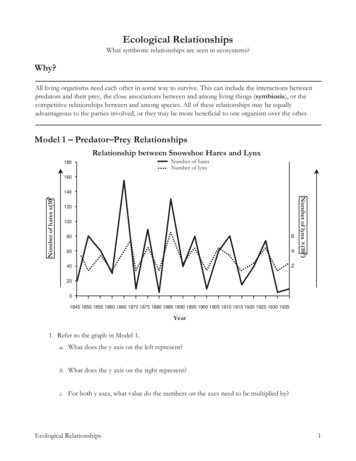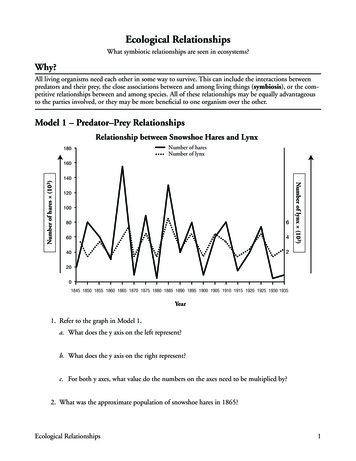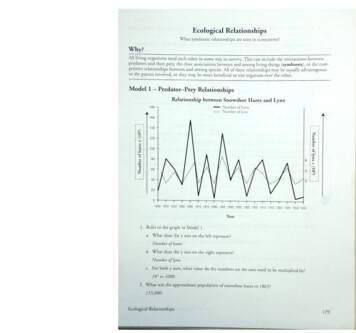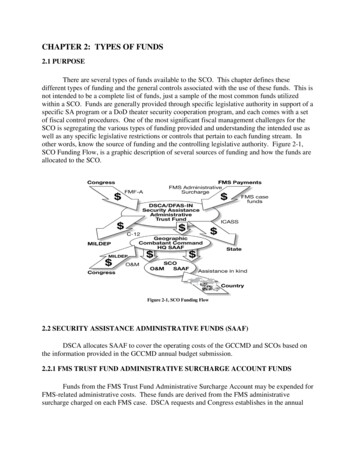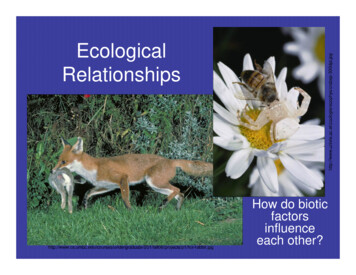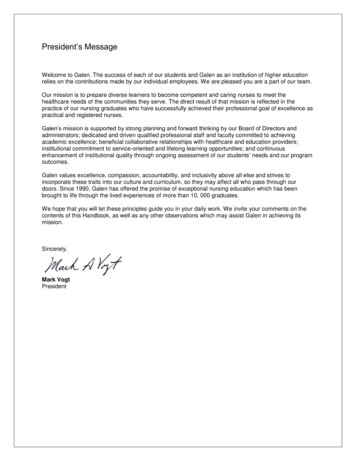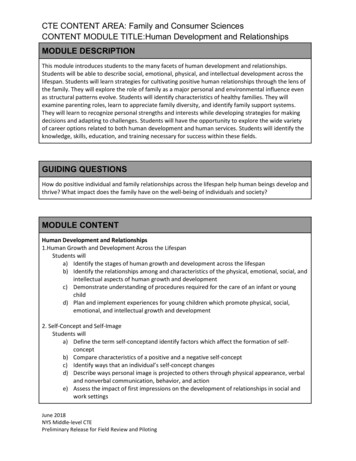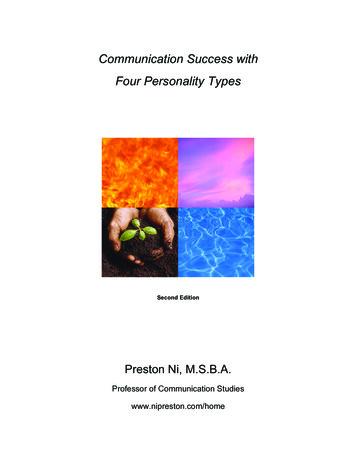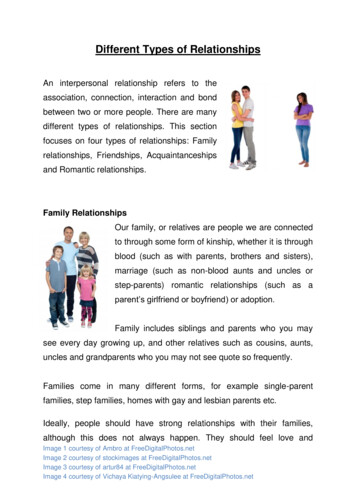
Transcription
Different Types of RelationshipsAn interpersonal relationship refers to theassociation, connection, interaction and bondbetween two or more people. There are manydifferent types of relationships. This sectionfocuses on four types of relationships: Familyrelationships, Friendships, Acquaintanceshipsand Romantic relationships.Family RelationshipsOur family, or relatives are people we are connectedto through some form of kinship, whether it is throughblood (such as with parents, brothers and sisters),marriage (such as non-blood aunts and uncles orstep-parents) romantic relationships (such as aparent’s girlfriend or boyfriend) or adoption.Family includes siblings and parents who you maysee every day growing up, and other relatives such as cousins, aunts,uncles and grandparents who you may not see quote so frequently.Families come in many different forms, for example single-parentfamilies, step families, homes with gay and lesbian parents etc.Ideally, people should have strong relationships with their families,although this does not always happen. They should feel love andImage 1 courtesy of Ambro at FreeDigitalPhotos.netImage 2 courtesy of stockimages at FreeDigitalPhotos.netImage 3 courtesy of artur84 at FreeDigitalPhotos.netImage 4 courtesy of Vichaya Kiatying-Angsulee at FreeDigitalPhotos.net
closeness for their relatives, and be able to confide in them and discusspersonal things. A key role of parents and older relatives is to offerguidance, support and, where needed, boundaries and discipline. Asfamilies are so close and spend so much time together, arguments anddisagreements can arise, but in most families, these are short-lived andeven in moments of anger or hurt, families still love and care about eachother.Family relationships are ideally life-long, although as children becometeenagers and then adults, it is usual for them to have moreindependence and for the parental relationship to become less one ofguidance and more one of mutual support.Sometimes as children become teenagers and adults, there can be anincrease in arguments and conflicts with parents as the growing childtries to assert their independence and find their adult identity. This isperfectly normal and often calms down once the teenage years havepassed.It is important to have strong communication with family members as, if ahealthy relationship is nurtured, a family can be a lifelong source ofsupport.The bond with a family can play a very important role in personalwellbeing and the ability to form other kinds of relationships outside ofthe family unit such as friendships and romantic relationships.In some families, there is little physical contact whereas in others, it iscommon for family members to express affection by means such asImage 1 courtesy of Ambro at FreeDigitalPhotos.netImage 2 courtesy of stockimages at FreeDigitalPhotos.netImage 3 courtesy of artur84 at FreeDigitalPhotos.netImage 4 courtesy of Vichaya Kiatying-Angsulee at FreeDigitalPhotos.net
hugging, kissing on the cheek or forehead, patting the head or touslingthe hair, patting on the back etc. It is common for babies and youngerchildren to be carried or held.FriendsFriends are people who we are not related to but choose to interact with.Friends are people we trust, respect, care about and feel that we canconfide in and want to spend time with. A good friendship should be builton honesty, support and loyalty. A friendship is a reciprocal relationship;for it to exist, both people must see each other as a friend.There are varying degrees of friendship.You may find that you feel closer to somefriends than others. This is perfectlynormal. Some friends, especially if theyhave only been known for a short time orare not seen very often, may not beappropriate to confide in about personal issues or concerns. You mayfind that you feel more comfortable and able to confide in friends whomyou have known for longer or spend more time with.Friends who are very close and know each other well are sometimesreferred to as “best friends”.Image 1 courtesy of Ambro at FreeDigitalPhotos.netImage 2 courtesy of stockimages at FreeDigitalPhotos.netImage 3 courtesy of artur84 at FreeDigitalPhotos.netImage 4 courtesy of Vichaya Kiatying-Angsulee at FreeDigitalPhotos.net
Some people have many friends, while others may only have one or two.There is no right or wrong number of friends to have and everyone isdifferent.Good friendships are mutually respectful and supportive and sharecommon interests and ideas.While some friendships can be close and some friends choose to greeteach other by hugging or kissing on the cheek, other friendships mayhave no physical contact, or may simply shake hands. Physicallyintimate or romantic contact is not appropriate in a friendship.AcquaintancesAcquaintances are people you may encounter regularly, but who are notfriends or relatives. For example, they may be a neighbour who lives inyour road that you say “hello” to if you see them in passing, or a workcolleague or someone you have seen a few times at a social event butdo not yet know well.It is important to be polite and respectful to acquaintances as havingharmonious relationships with people around you, such as workcolleagues, people from college, neighbours etc is an important way ofavoiding stress or conflict.In some cases, relationships that start as acquaintanceships can, overtime, evolve into friendships as you get to know the person better andsee them more frequently.Image 1 courtesy of Ambro at FreeDigitalPhotos.netImage 2 courtesy of stockimages at FreeDigitalPhotos.netImage 3 courtesy of artur84 at FreeDigitalPhotos.netImage 4 courtesy of Vichaya Kiatying-Angsulee at FreeDigitalPhotos.net
The level of contact with an acquaintance is minimal. There is unlikely tobe any physical contact (although in a work setting, or when beingintroduced to someone, you might occasionally be required to shakehands), but the main form of contact is likely to be smiling and saying‘hello’.Romantic RelationshipsA romantic relationship is one in which you feel very strongly attracted tothe other person, both to their personality and, often, also physically.This is reciprocated by the other person in the relationship.A romantic relationship is that which exists between a boyfriend andgirlfriend (in a heterosexual relationship) or a boyfriend and boyfriend orgirlfriend and girlfriend (in a homosexual relationship) or spouses (in amarriage) or life partners (in a civil partnership or long-term unmarriedrelationship).People in a romantic relationship will see each other very often andwhen apart my frequently stay in contact, for example by phone. Somepeople in romantic relationships live together.A romantic relationship is the closest form of relationship and the twopeople involved will often describe themselves as being attracted toeach other and/or “in love”. They feel an incredibly strong connectionand bond to each other that they do not feel with anyone else, evenclose friends, and the bond is also exclusive and monogamous.Image 1 courtesy of Ambro at FreeDigitalPhotos.netImage 2 courtesy of stockimages at FreeDigitalPhotos.netImage 3 courtesy of artur84 at FreeDigitalPhotos.netImage 4 courtesy of Vichaya Kiatying-Angsulee at FreeDigitalPhotos.net
Successful Romantic relationships are built on love,trust, respect, support, acceptance, shared interestsand a desire for the two people involved to sharetheir lives together. Some people in relationships maychoose to have children.As this is such a close relationship, various kinds ofphysical contact are accepted which would not beappropriate in any other kind of relationship. These include prolongedcuddling and holding, kissing on the lips and sexual intercourse,however it should still mutually manticrelationships. In strong relationships, these arguments can be overcomethrough effective communication, understanding and compromise, but inother cases, especially if there are frequent arguments, the two peopleinvolved my decide to terminate the relationship.Relationships can be of varying duration. In some relationships, it quicklybecomes apparent that the two people involved are not compatible anddo not want to spend their lives together, and so the relationship mayend after only a few months. In other cases, the two people may betogether for many years or may stay together for the rest of their lives.Image 1 courtesy of Ambro at FreeDigitalPhotos.netImage 2 courtesy of stockimages at FreeDigitalPhotos.netImage 3 courtesy of artur84 at FreeDigitalPhotos.netImage 4 courtesy of Vichaya Kiatying-Angsulee at FreeDigitalPhotos.net
People in a romantic relationship will see each other very often and when apart my frequently stay in contact, for example by phone. Some people in romantic relationships live together. A romantic relationship is the closest form of relationship and the two people invo
